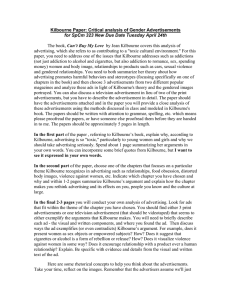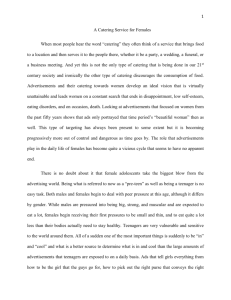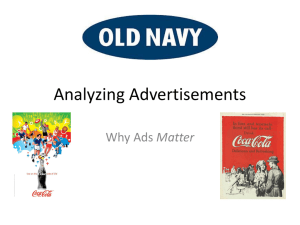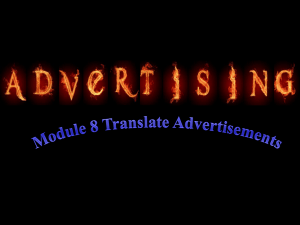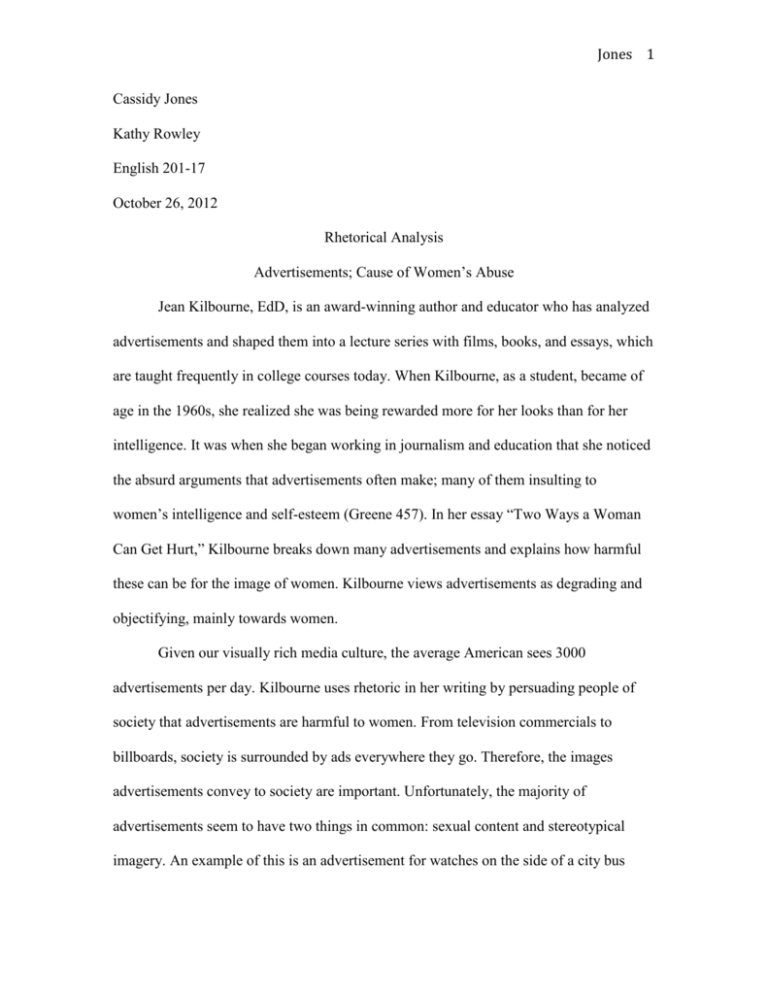
Jones 1
Cassidy Jones
Kathy Rowley
English 201-17
October 26, 2012
Rhetorical Analysis
Advertisements; Cause of Women’s Abuse
Jean Kilbourne, EdD, is an award-winning author and educator who has analyzed
advertisements and shaped them into a lecture series with films, books, and essays, which
are taught frequently in college courses today. When Kilbourne, as a student, became of
age in the 1960s, she realized she was being rewarded more for her looks than for her
intelligence. It was when she began working in journalism and education that she noticed
the absurd arguments that advertisements often make; many of them insulting to
women’s intelligence and self-esteem (Greene 457). In her essay “Two Ways a Woman
Can Get Hurt,” Kilbourne breaks down many advertisements and explains how harmful
these can be for the image of women. Kilbourne views advertisements as degrading and
objectifying, mainly towards women.
Given our visually rich media culture, the average American sees 3000
advertisements per day. Kilbourne uses rhetoric in her writing by persuading people of
society that advertisements are harmful to women. From television commercials to
billboards, society is surrounded by ads everywhere they go. Therefore, the images
advertisements convey to society are important. Unfortunately, the majority of
advertisements seem to have two things in common: sexual content and stereotypical
imagery. An example of this is an advertisement for watches on the side of a city bus
Jones 2
using bondage. The ad depicts a naked women bonded by the watches the company is
proposing to sell. (Cite). These images can be dangerous for women and give men the
wrong ideas. Instead of them thinking that’s a nice watch, they are seeing a woman
objectified to sex. Instead of advertisements telling people what they need to know about
the product itself, they paint a picture of how the product will change and/or affect us.
Instead of Hollister advertisements showing the cute outfits they have for sale, they
usually consist of half naked models. Ads tell us that their product will make us happier,
help us find the perfect guy, or help a guy find the perfect girl. Victoria’s Secret tempts
young women with blatantly sexual ads promising that their lingerie will make them
irresistible (Kilbourne 463). These advertisements are giving society a false correlation.
If you wear there product, you will obtain this happiness; false. Advertisers use sexual
content to catch the attention of today’s society, which can cause other problems as well.
Throughout her essay, Kilbourne teaches society how the images advertisements
give society are harmful and can lead to increased abuse. In some ads women are shown
dead or in the process of being killed. “Great hair never dies,” says an ad featuring a
female corpse lying on a bed, her breast exposed (465). This ad is degrading to women.
Instead hair ads should show happy beautiful women with full healthy hair, because they
used that product. While some may think that Kilbourne is being to selective on her
choice of ads, whether there is more or less harmful advertisements, they do exist.
Kilbourne teaches society that when women are shown in powerless and submissive
positions, the message to men is clear: women are always available as the targets of
aggression and violence, women are inferior to men and thus deserve to be dominated,
and women exist to fulfill the needs of men (477). In “Two Ways a Woman Can Get
Jones 3
Hurt,” Kilbourne is reaching out to educate the men and women of society with her
second audience being the advertising industry. Men are learning from these
advertisements to be aggressive and dominate, which is not always moral and/or right. In
the article, pathos is being used by scaring women of the dangers they are exposed to.
Women in advertisements are being viewed as objects instead of human beings. Instead
of women being the model and representing the product, they begin to become a play toy
associated with the product. Yes, men may be objectified in advertisements too, but there
is a world of difference between the objectification of men and that of women. The most
important difference is that there is no danger for most men, whereas objectified women
are always at risk. Ads featuring images of male violence against women portrays a truth
that we are all aware of (467). This explains why women are afraid to walk home alone in
the dark while men are not. It explains why a woman being approached by a group of
men is more likely to be scared of being sexually assaulted then a man being approached
by a group of women. When women start becoming less than human, that is when the
abuse and degrading begins. The underlying meaning behind the images advertisements
give to society are harmful and lead to increased abuse.
The resulting potential abuse from advertisements tell gives us some ideas about
our culture. Through our culture, we learn that advertisements also support the idea that,
not only are innocent women sexy, but also when women say no, they really mean yes. A
perfume ad featured in many teen magazines features a young woman with the saying,
“Apply generously to your neck so he can smell the scent as you shake your head ‘no’”
(462). Another ad for a bar in Georgetown features a close up of a cocktail and the
headline, “If your date won’t listen to reason, try a velvet hammer” (462). These images
Jones 4
are reinforcing that women do not mean no in men’s minds. Also the second example is
clearly stating that if a man cannot get his date to do whatever it is he wants (probably
sexual) the solution is get her drunk. While sometimes women do say “no,” as playing
hard to get, more over they say no cause they mean no, and these advertisements are
simply encouraging rape. Sadly, these degrading ads are not always meant merely for
men.
If all ads portraying male violence against women were ads for men, at least
society would know women are not overseeing it, however that is not the case. An ad that
ran in the Czech version of Elle portrays three men attacking a woman, and the terrifying
image is being used to sell jeans to women. This means advertisers must believe that
women would find this image compelling or attractive (464). What is the real reason
these ads do persuade women buyers, to purchase these jeans? Is the ad simply designed
to get our attention, to shock us? Or even worse is it designed to play into women’s
fantasies of domination? I feel that these advertisements are shocking to most women and
therefore remain in our thoughts, which is what the advertiser is hoping for. Some of us
become numb to these images, just as we become numb to the daily litany in the news of
women being raped, battered, and killed (465). The fact of the matter is, our culture has
become so used to seeing the use of sexual content as well as abuse and rape of women,
that they are no longer alerted or concerned when seeing these images. These images are
degrading to society. The Global Report on Women’s Human Rights concluded that,
“domestic violence is a leading cause of female injury in almost every country in the
world and is typically ignored by the state or only erratically punished.” (466). If this is
the case, how do advertisers get away with promoting it? No, ads do not directly cause
Jones 5
violence, but these images do contribute to objectification and degrading of women,
which does lead to violence.
A main source for this information comes from Kilbourne’s book Deadly
Persuasion: Why Women and Girls Must Fight the Addictive Power of Advertising. Jean
Kilbourne has written many articles and several more books on this controversial topic.
She has also released a film titled Killing Us Softly: Advertising’s Image of Women
(Greene 458). By using all these genres, her message is sure to be heard. Women and
men of society need to be aware of the many dangers advertising puts forth. Women are
targets when it comes to advertising. Whether they are objectifying or degrading, ads are
making women less human and seen more as an object.
Has Kilbourne been successful in getting her message out?
Advertising helps to create a climate in which certain attitudes and values
flourish, such as the attitude that women are valuable only as objects of men’s desire, that
real men are always sexually aggressive, that violence is erotic, and that women who are
victims of sexual assault “asked for it,” (Kilbourne 478). In her essay, Kilbourne, EdD,
broke down many advertisements and taught us how harmful these images are for
women. Advertisements are degrading and objectifying, mainly towards women.
Jones 6
Works Cited
Greene, Stuart and April Lidinsky, eds. From Inquiry to Academic Writing. Boston:
Bedford/St. Martin’s, 2012. Print.
Kilbourne, Jean. “Two Ways a Woman Can Get Hurt”: Advertising and Violence. From
Inquiry to Academic Writing. Stuart Greene and April Lidinsky, eds. Boston:
Bedford/St. Martin’s, 2012. Print.

